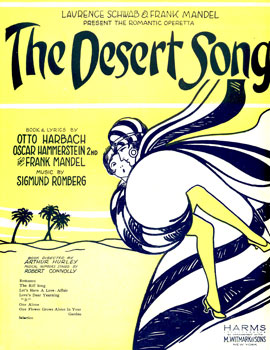
The Desert Song is an operetta with music by Sigmund Romberg and book and lyrics by Oscar Hammerstein II, Otto Harbach and Frank Mandel. It was inspired by the 1925 uprising of the Riffs, a group of Berber fighters, against French colonial rule in Morocco. It was also inspired by stories of Lawrence of Arabia aiding native guerrillas. Many tales romanticizing Saharan North Africa were in vogue, including Beau Geste and The Son of the Sheik.

Richard White is an American actor and opera singer best known for voicing the character of Gaston in Disney's Beauty and the Beast. He also voiced the character in the early 2000s animated TV series House of Mouse.
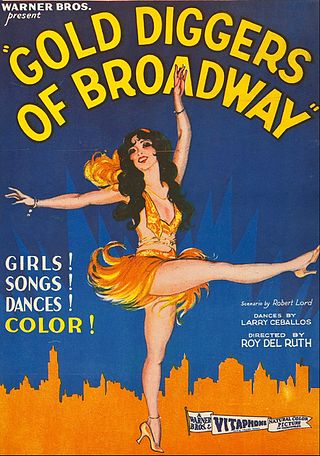
Gold Diggers of Broadway is a 1929 American pre-Code musical comedy film directed by Roy Del Ruth and starring Winnie Lightner and Nick Lucas. Distributed by Warner Bros., the film is the second all-talking, all-Technicolor feature-length film.
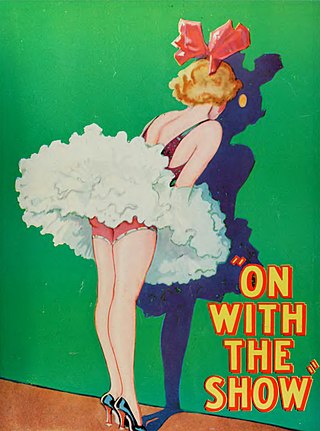
On with the Show! is a 1929 American pre-Code musical film produced by Warner Bros. Filmed in two-color Technicolor, the film is noted as the first all-talking, all-color feature length film, and the second color film released by Warner Bros.; the first was the partly color, black-and-white musical The Desert Song (1929).

John Boles was an American singer and actor best known for playing Victor Moritz in the 1931 film Frankenstein.

The Show of Shows is a 1929 American pre-Code musical revue film directed by John G. Adolfi and distributed by Warner Bros. The all-talking Vitaphone production cost almost $800,000 and was shot almost entirely in Technicolor.

Song of the West is a 1930 American Pre-Code musical western film produced by Warner Bros., and photographed entirely in Technicolor. It was based on the 1928 Broadway musical Rainbow by Vincent Youmans (music), Oscar Hammerstein II (lyrics) and Laurence Stallings (book). It starred John Boles, Joe E. Brown and Vivienne Segal, and was the first all-color all-talking feature to be filmed entirely outdoors.

Sally is a 1929 Hollywood film. It is the fourth all-sound, all-color feature film made, and it was photographed in the Technicolor process. It was the sixth feature film to contain color that had been released by Warner Bros.; the first five were The Desert Song (1929), On with the Show! (1929), Gold Diggers of Broadway (1929), Paris (1929) and The Show of Shows (1929).. Although exhibited in a few theaters in December 1929, Sally entered general release on January 12, 1930.

Song of the Flame is a 1930 American pre-Code musical film photographed entirely in Technicolor. Based on the 1925 operetta of the same name, the film features a screenplay by Gordon Rigby adapted from the musical book written by Oscar Hammerstein II and Otto A. Harbach for the operetta. The movies also features many of the songs from the operetta which used lyrics by Hammerstein and Orbach and music by George Gershwin and Herbert Stothart. The film was produced and distributed by First National Pictures. It was the first color film to feature a widescreen sequence, using a process called Vitascope, the trademark name for Warner Bros.' widescreen process. The film, based on the 1925 Broadway musical of the same name, was nominated for an Academy Award for Sound Recording. It is part of the tradition of operetta films, popular at the time.

Bride of the Regiment is a 1930 American pre-Code musical film directed by John Francis Dillon and filmed entirely in Technicolor. The screenplay by Ray Harris and Humphrey Pearson is based on the book of the 1922 stage musical The Lady in Ermine by Frederick Lonsdale and Cyrus Wood, which had been adapted from the 1919 operetta Die Frau im Hermelin by Rudolph Schanzer and Ernst Welisch. The story is a remake of a 1927 First National silent film, The Lady in Ermine, that starred Corinne Griffith. It was later remade by 20th Century-Fox as That Lady in Ermine (1948) starring Betty Grable and Douglas Fairbanks Jr.

Paris is a 1929 American pre-Code musical comedy film, featuring Irène Bordoni. It was filmed with Technicolor sequences: four of the film's ten reels were originally photographed in Technicolor.

The Desert Song is a 1943 American musical film. It was directed by Robert Florey and starred Dennis Morgan, Irene Manning and Bruce Cabot. It is based on the 1926 operetta with music by Sigmund Romberg. It was nominated for an Academy Award for Best Art Direction.
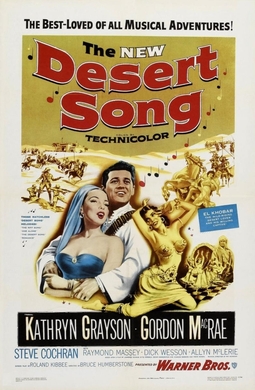
The Desert Song is a 1953 film version in Technicolor of Sigmund Romberg's operetta. It is the third film version of the operetta, the third made by Warner Bros., and the second in full three-strip Technicolor. Although it was released in 1953, it was not made in widescreen; at that time Twentieth-Century Fox held the rights to Cinemascope, which was introduced that year in the film The Robe.

Hardboiled Rose is a 1929 American part-talkie romantic drama film directed by F. Harmon Weight and released by Warner Bros. It starred Myrna Loy, William Collier, Jr., and John Miljan.

The Midnight Taxi is a 1928 American early part-talkie thriller picture from Warner Bros. directed by John G. Adolfi and starring Antonio Moreno, Helen Costello, and Myrna Loy. According to the Library of Congress, it has a completed copy of the film and found at British Film Institute's National Film and Television Archive.

The Squall is a 1929 American pre-Code drama film directed by Alexander Korda and starring Myrna Loy, Richard Tucker, Alice Joyce and Loretta Young, and based on the 1926 play The Squall by Jean Bart.
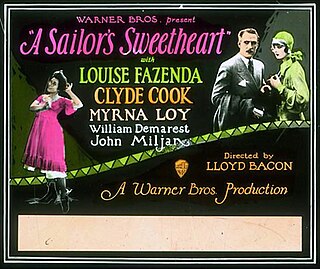
A Sailor's Sweetheart is a 1927 Warner Bros. silent film comedy directed by Lloyd Bacon. It stars Louise Fazenda and Clyde Cook. It was released with a Vitaphone soundtrack with a music score and sound effects.

Why Girls Go Back Home is a lost 1926 American silent comedy drama film produced and distributed by Warner Bros. James Flood directed and Patsy Ruth Miller and Clive Brook starred. Myrna Loy has a feature role. The film is a sequel to Warner Bros.'s 1921 Why Girls Leave Home, which was a box office hit.
Simple Sis is a 1927 American silent comedy-melodrama directed by Herman C. Raymaker and starring Louise Fazenda as a poor, plain laundress hoping for romance, supported by Clyde Cook as a shy suitor and Myrna Loy as a cruel beauty.

Pay as You Enter is a 1928 American comedy film directed by Lloyd Bacon and starring Louise Fazenda, Clyde Cook and William Demarest.



















